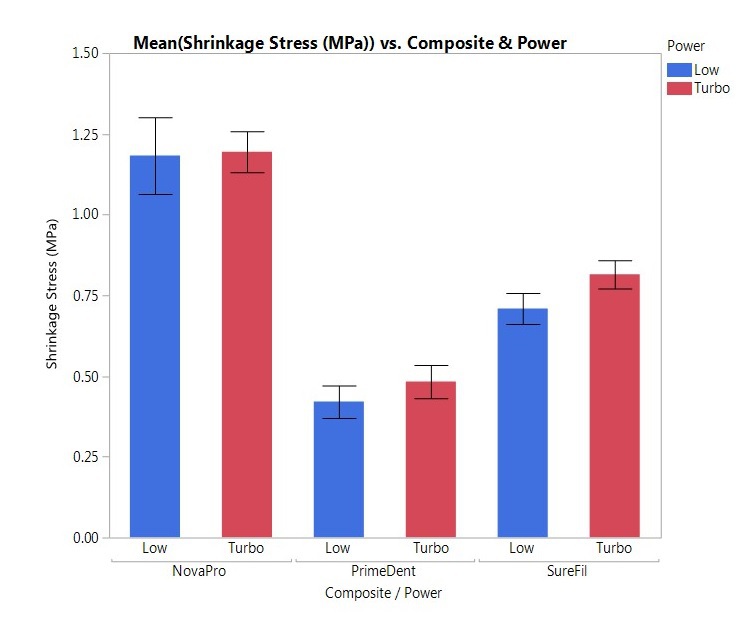IADR Abstract Archives
Effect of Curing Light Intensity on Polymerization Shrinkage Stress
Objectives: Curing units with very high intensity are more popular in dentistry with the potential advantage of quick curing and high degree of conversion. However, the polymerization shrinkage stress of resin composite under a high cuing intensity is still a concern. This study is to assess the effect of curing light intensity on polymerization shrinkage stress of flowable resin composite.
Methods: Three flowable composite resins, 1) Prime-Dent flowable composite, 2) NOVAPRO Flow (Nanova Biomaterials), and 3) SureFil SDR Flow+ Bulk Fill Flowable (Dentsply Sirona) were tested in this study. Two fused silica glass rods with flat surfaces were used to make a composite resin cylinder of 1.5mm in height. The rod ends were roughened with 45µm sand paper and treated with bonding agent Scotchbond Universal Adhesive (3M ESPE) and light cured. The two rods were fixed vertically by two chucks attached to 100N load cell in a universal testing machine (Instron 5566A). Tested composite resins were injected into the cylindrical gap and carefully shaped, then light cured from one direction at same distance about 2 mm. The tested composites were cured under two different intensities – low intensity of 400 mW/cm2 (Soft mode of Bluephase 16i) for 45 seconds and high intensity of 1400 mW/cm2 (Turbo mode of Bluephase 20i) for 13 seconds, with similar total light energy output. The contraction load during polymerization was recorded with Bluehill 3 software. Peak load was acquired at 5 mins after the curing light started and calculated into shrinkage stress. One-way ANOVA post hoc Tukey HST (JMP Pro 13) was used to analyze the difference of shrinkage stresses among groups (significance level = 0.05).
Results: Figure 1 shows the polymerization shrinkage stresses of tested flowable composites cured at two different light intensity. In general, higher curing intensity produced significant higher shrinkage stresses. NovaPro Flow composite showed no significant different shrinkage stresses between low and high curing intensity.
Conclusions: Using a very high curing intensity for resin based composite may cause high polymerization shrinkage stress and proper curing intensity should be carefully considered in clinical.
Methods: Three flowable composite resins, 1) Prime-Dent flowable composite, 2) NOVAPRO Flow (Nanova Biomaterials), and 3) SureFil SDR Flow+ Bulk Fill Flowable (Dentsply Sirona) were tested in this study. Two fused silica glass rods with flat surfaces were used to make a composite resin cylinder of 1.5mm in height. The rod ends were roughened with 45µm sand paper and treated with bonding agent Scotchbond Universal Adhesive (3M ESPE) and light cured. The two rods were fixed vertically by two chucks attached to 100N load cell in a universal testing machine (Instron 5566A). Tested composite resins were injected into the cylindrical gap and carefully shaped, then light cured from one direction at same distance about 2 mm. The tested composites were cured under two different intensities – low intensity of 400 mW/cm2 (Soft mode of Bluephase 16i) for 45 seconds and high intensity of 1400 mW/cm2 (Turbo mode of Bluephase 20i) for 13 seconds, with similar total light energy output. The contraction load during polymerization was recorded with Bluehill 3 software. Peak load was acquired at 5 mins after the curing light started and calculated into shrinkage stress. One-way ANOVA post hoc Tukey HST (JMP Pro 13) was used to analyze the difference of shrinkage stresses among groups (significance level = 0.05).
Results: Figure 1 shows the polymerization shrinkage stresses of tested flowable composites cured at two different light intensity. In general, higher curing intensity produced significant higher shrinkage stresses. NovaPro Flow composite showed no significant different shrinkage stresses between low and high curing intensity.
Conclusions: Using a very high curing intensity for resin based composite may cause high polymerization shrinkage stress and proper curing intensity should be carefully considered in clinical.

